Roger J. Wendell
Defending 3.8 Billion Years of Organic EvolutionSM



|
Hiking |
People usually consider walking on water or in thin air a miracle.
But I think the real miracle is not to walk either on water or in thin
air, but to walk on earth. Every day we are engaged in a miracle
which we don't even recognize: a blue sky, white clouds, green
leaves, the black, curious eyes of a child -- our own two eyes.
All is a miracle.
- Thich Nhat Hanh
NOTE: LIDAR (Light Detection and Ranging) was put into use many decades after I started hiking and climbing. LIDAR is a more accurate way of measuring the Earth's surface and, as such, has changed what was believed to be the elevation of many mountains and highpoints. As a result, the "prominence" (at least 300 feet above a connecting saddle) of many mountains has changed along with their elevations. A personal example, for me, is Republican Mountain - a previously "unranked" 12er near Silver Plume that I climbed in 2022 after learning that LIDAR had determined it now had 312 feet of prominence. Peak 8, near Breckenridge is another personal example of change brought on by LIDAR. When I originally climbed Peak 8 I believed it to be a 12er, only to learn later that it's actual elevation is 13,005 feet! So, in summary, many of the elevations you see on my pages may not (yet) be accurate - requiring an update someday in the future as time permits!
"You can't see anything from a car; you've got to get out of the goddamn contraption and walk, better yet crawl, on hands and knees, over the sandstone and through the thornbrush and cactus. When traces of blood begin to mark your trail, you'll see something, maybe.""Benedicto: May your trails be crooked, winding, lonesome, dangerous, leading to the most amazing view. May your mountains rise into and above the clouds. May your rivers flow without end, meandering through pastoral valleys tinkling with bells, past temples and castles and poets' towers into a dark primeval forest where tigers belch and monkeys howl, through miasmal and mysterious swamps and down into a desert of red rock, blue mesas, domes and pinnacles and grottos of endless stone, and down again into a deep vast ancient unknown chasm where bars of sunlight blaze on profiled cliffs, where deer walk across the white sand beaches, where storms come and go as lightning clangs upon the high crags, where something strange and more beautiful and more full of wonder than your deepest dreams waits for you --- beyond that next turning of the canyon walls."
- Edward Abbey

1,000 Times to the top of Mount Morrison!
A few days before my 66th birthday, after a number of years of continuous effort, I made it to the top of Mount Morrison for the one thousandth time on November 8th, 2021! This amounted to 2 million feet (609,600 metres) of overall elevation gain for a distance of 3,800 miles (6,115.5 kilometres).
Mount Morrison is located in Jefferson County, Colorado and overlooks the famous Red Rocks Amphitheatre. Morrison's summit is at 7,881 feet (2,402 metres) with overall elevation gain of about 2,000 feet (609 metres). Mount Morrison has 741 (225.8 metres) feet of prominence with nearby Genesee Mountain as its line parent.
At the time I lived within about 10 kilometres of the trailhead so using Mount Morrison for regular exercise was relatively handy. However, in addition to using Mount Morrison for exercise and training, I always found it to be a pleasant escape from Denver's noise, congestion, and smog. But, like everything else on our crowded planet, Mount Morrison became heavily used and eroded, especially during COVID. So, I feel lucky that I was able to complete a thousand climbs (there's some scrambling on the summit block if you follow the original route) before the trail was substantially altered and modified. And, as best that I and a number of "regulars" can tell, I am the first to have completed 1,000 ascents. But, hopefully, future crowding won't be so severe and others will be able to enjoy Mount Morrison as much as I have!* †
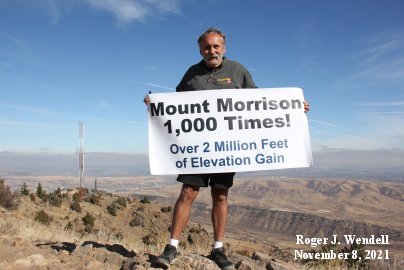 Me on top (with Green Mountain behind me) |
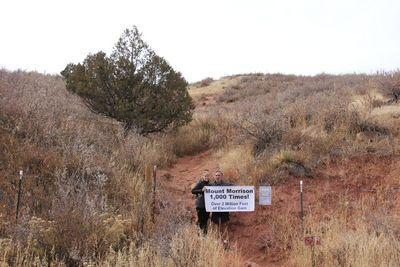 Me and Donna at the trailhead |
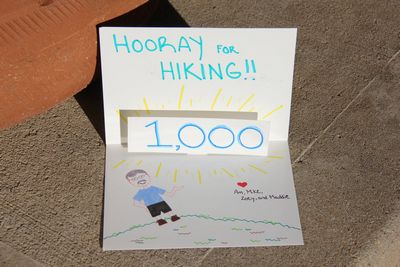 Handmade card from Amber! |
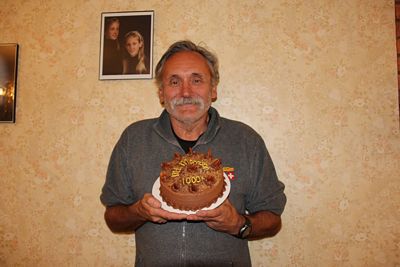 Masterpiece Cakeshop from Donna! |
*After completing a thousand hikes to the top I continued
scaling Mount Morrison albeit less frequently - spending
some of my other workout days on Mount Falcon, Bergen
Peak, and other local trails...
Recognition from the Colorado Mountain Club!
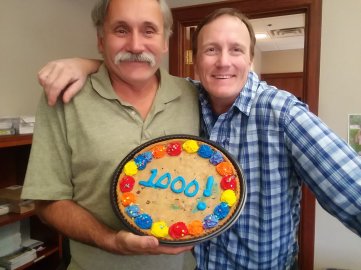
CMC Executive Director Keegan Young presented me with this tasty bit of recognition!

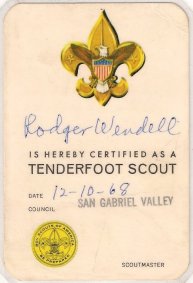
|
|
Saunterers

My Hiking History
Me and Steve Hoffmeyer negotiating a creek in the Holy Cross Wilderness, 2005
Photo by Vic BradfordDespite all of the climbing, swimming, cycling, flying, and driving I've done hiking remains the one activity that's been with me the longest throughout my life. From about ages 12 through 16 I hiked extensively throughout the San Gabriel Mountains of Southern California - especially exploring Santa Anita Canyon, Mt. Wilson, and all the surrounding camps and trails (always stopping, of course, at Chantry Flats to load up on snacks and refreshments!).
Prior to age 12 I hiked, extensively, the creek beds and streams of the Los Angeles foothills area (yes, L.A. had creek beds and streams at one time!) and the rolling fields of eastern Nebraska. From my earliest age I was out walking through Nature every chance I got (ask my mom!). From about age 16 on I did most of my hiking all over Colorado's portion of the Rocky Mountains. This was mixed with travel and extensive hikes in Grand Canyon, Hawai'i, Mexico, Canada, Africa, Argentina, and China. I heartily endorse hiking because it's darn good for your health, has a relatively low impact on the environment, and puts your pretty darn close to nature without requiring too much expensive equipment or clothing.
Except for maybe Jean George's book My Side of the Mountain (I read it in 1969 when I was 13), I didn't do much reading about the outdoors until 1974 when I read Colin Fletcher's The Complete Walker. It isn't that I don't recommend you read and learn before getting involved outdoors it's just that I was too darn busy hiking, in my teens, to do much reading myself!

Trails!
Miscellaneous Trails:
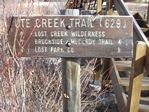 Lost Creek Wilderness |
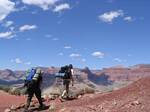 Grand Canyon |
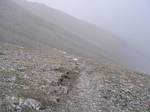 Trail to Mt. Shavano |
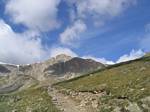 Trail to Torreys |
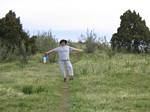 Tami on Morrison |
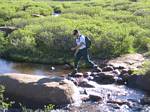 Brian to Bierstadt |
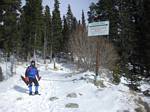 St Mary's Glacier |
I know it probably sounds goofy to read, on a hiking website, that the author loves trails - nevertheless that's how I feel! I mention my love for trails because I have so much additional experience without them. In addition to having done lots of scrambling or kicking steps and "post-holing" through snow, I've lost a trail or two and got really worried when I couldn't find 'em a day or two later!To me, trails are lovely little routes that have taken me through all kinds of wonderful terrain with relative confidence about my whereabouts and destination. Plus, even more importantly, they are relatively low-impact in that I'm not crushing flowers or scuffing lichens in my attempt to get from point A to B. Properly maintained trails really do help the landscape by keeping us two-leggeds in a narrow little corridor so the rest of nature can flourish around us unmolested. I recommend we avoid "cross-country" travel, whenever possible, and take full advantage of literally millions of trails throughout our country and around the globe....
- Roger J. Wendell
October 30, 2005
Please stay the trail!
Mesa Trail:
Each New Year's Day Larry DeSaules leads a dozen to 15 of us up the Mesa Trail from El Dorado Springs to Chautauqua Park in Boulder, Colorado. Total one-way distance is 11 kilometres (7 miles) so we shuttle vehicles to get us from one end, to the other, usually stopping at Pasta J's or some other Boulder restaurant before heading back to the Denver area. It's always been a great way to bring in the new year!
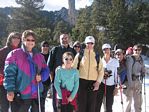 Photo by Larry |
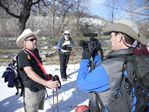 Filming for the Travel Channel |
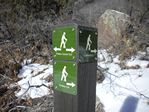 Which way? |
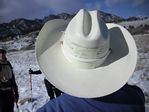 Don't forget to call Peggy! |
 Girl Power! |
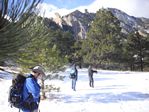 Maiden and the Thumb |

|
Click Here for a YouTube video of Larry's Man Bag and a humorous descritpion of a Mt. Everest climb... |

Continental Divide National Scenic Trail:
Me and Teresa MartinezAt the time of this posting, 2019, Teresa Martinez had already been Executive Director (and co-founder) of the Continental Divide Trail Coalition since 2012. And, for much of that time, I worked across the building from her (at the American Mountaineering Center in Golden, Colorado) and enjoyed many pleasant encounters with her at events, meetings, and gatherings. Teresa has done a great job for her organization who, in turn, have done a fantastic job on the trail. It's been a pleasure knowing and working with her!
Here's some information about the trail from the CDTC website; "The Continental Divide National Scenic Trail (CDNST) was designated by Congress in 1978 as a unit of the National Trails System. The 3,100 mile CDNST traverses the magnificent Continental Divide between Mexico and Canada. It travels through 25 National Forests, 21 Wilderness areas, 3 National Parks, 1 National Monument, 8 BLM resource areas and through the states of Montana, Idaho, Wyoming, Colorado and New Mexico. The vision for the Continental Divide National Scenic Trail is to create a primitive and challenging backcountry trail on or near the Continental Divide to provide people with the opportunity to experience the unique and incredibly scenic qualities of the area."

Appalachian Trail:
Me and Scott JurekScott Jurek holds the Appalachian Trail Thru-Hike Speed Record - 3,522.8 kilometres (2,189 miles) in 46 days, 8 hours and 7 minutes! He completed the hike on July 12, 2015. In the photo that's him on my left, just over half a year since the hike and only a month since he had regained his weight back from the ordeal. It's interesting to note that at the time of this photo, in early 2016, he had been a vegan since 1999! The Appalachian Trail is also known as the Appalachian National Scenic Trail or simply the "A.T." It's a marked hiking trail in the eastern United States extending between Springer Mountain, in the state of Georgia and Mount Katahdin in Maine. At the time of this photo the trail was 3,522.8 kilometres (2,189 miles) long, though the precise length changes over time as parts are modified or rerouted. The trail passes through the states of Georgia, North Carolina, Tennessee, Virginia, West Virginia, Maryland, Pennsylvania, New Jersey, New York, Connecticut, Massachusetts, Vermont, New Hampshire, and Maine. At the time of this photo the path was being maintained by 31 trail clubs and multiple partnerships, and managed by the National Park Service, United States Forest Service, and the nonprofit Appalachian Trail Conservancy. The majority of the trail is in forest or wild lands, although some portions traverse towns, roads and farms. The trail conservancy claims that the Appalachian Trail is the longest hiking-only trail in the world...
The Appalachian Trail Conservancy's mission statmen states their purpose as; "...to preserve and manage the Appalachian Trail - ensuring that its vast natural beauty and priceless cultural heritage can be shared and enjoyed today, tomorrow, and for centuries to come."

Colorado Trail:
In 2018, the Colorado Trail Foundation's website described the trail like this; "The Colorado Trail is Colorado's premier long distance trail. Stretching almost 500 miles [804 kilometres] from Denver to Durango, it travels through the spectacular Colorado Rocky Mountains amongst peaks with lakes, creeks and diverse ecosystems. Trail users experience six wilderness areas and eight mountain ranges topping out at 13,271 feet [4,045 metres], just below Coney Summit at 13,334 feet [4,064 metres]. The average elevation is over 10,300 feet [3,139 metres] and it rises and falls dramatically. Users traveling from Denver to Durango will climb 89,354 feet [27,235 metres]."
Me and Gudy Gaskill[Gudrun "Gudy" Gaskill, 1927 - 2016]
I had the pleasure or regularly meeting with Gudy at the Colorado Mountain Club office in Golden. She even did a water color for me, of a guy climbing a peak, but I can't find it after having moved [darn!]. Gudy was a mountaineer who is regarded as the driving force behind the creation of the Colorado Trail. Beginning in the 1970s, Gudy helped plan out the route, solicited donations, and recruited teams of volunteers to work in one-week shifts developing the Trail each summer. Gudy was named executive director of the newly formed Colorado Trail Foundation and was inducted into the Colorado Women's Hall of Fame in 2002.
Me and Dona HildebrandRetired Air Force Lt Colonel Dona Hildebrand was in the first group of people to hike the entire length of the Colorado Trail. This took place in 1988 when the trail was 477 miles long. The small group of her fellow hikers included the trail's founder, Gudy Gaskill, and other Colorado Mountain Club luminaries. The book she's holding is the Colorado Trail Data Book (6th Edition).
Me and Bill ManningBill Manning was the long-time director of the Colorado Trail Foundation. Bill and I literally worked within 15 feet of each other from 2013 to 2022! (he started with the CTF well before that but 2013 was when I started work nextdoor to him...) But, of course, my desk is on the Colorado Mountain Club side of the door you see in this picture - the photo was taken in Bill's office. So, I've been fortunate to run into Bill almost every day, over the years, and have always enjoyed my encounters with him and his staff. (at the time of this writing, in 2019, his entire staff consisted of Office Manager Amy Nelson and Field Operations Manager Brent Adams) The Colorado Trail Foundation is a great organization that is directly responsible for maintenance of the world's most beautiful trail!

Cairns:
Cairn - Flat Top Mountain, COA cairn (pronounced as a single syllable!!!) is usually a pile of rocks that marks a trail or boundary. I've seen some cairns that have a stick or pole jutting out of the top to make them more visible - sometimes over 3 metres (10 feet) high. I've also seen cairns that were so small they'd fit in the palm of your hand. These tiny cairns are usually in desert areas, like Grand Canyon, where the trail or route follows a canyon contour or crosses up a series of ledges that are steep and narrow. I think there's an unwritten "rule" that cairns should be a minimum of three pebbles, stones or rocks piled vertically when possible. This is because it's very unusual, in nature, to find three rocks just sitting on top of each other. But, like I mentioned above, huge piles of rocks serve the purpose as well. In places where the trail is really hard to follow, or it gets covered with snow, the idea is to place the cairns close enough so that the next one can be seen from the previous.
- Roger J. Wendell
Golden, CO - 2005
Snow Cairn?I'm not sure if somebody put this "Snow Cairn" alongside Mesa Trail (Boulder, Colorado) for fun or not but the rule remains; "Don't disturb a cairn!"

Peak One:
On June 26, 2005 CMC leader Terry Chontos
took all five of us to the top of this 12,805' peak located near
Frisco, Colorado. The steep climb took us three hours and twenty
minutes - a bit faster than most! We made the summit during a break
in the weather - enduring some light "corn snow" and rain along
certain portions of the mountain...
Although this particular flag is pretty beat up I went ahead and posted it
here, and on my 4th of July page anyway. I don't
know who the keeper of the flag is but I'm sure their intentions are good
despite the horrendous winds that frequent this peak daily!!

Miscellaneous Hikes:
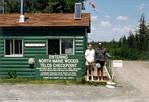 North Maine Woods - Amber, Tami and I drove there from Denver! |
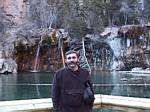 Me at Hanging Lake, Glenwood Canyon, 3 Weeks to-the-day after foot surgery. 2.5 Miles roundtrip, 1000+ feet gain. |
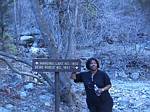 Coworker Linda agreed to accompany me to Hanging Lake on that warm Spring day in 2002... |
 My Mount Kenya hiking certificate from a trip to Africa in 2003... |
Hiking through the Colorado National Monument
Cryptogamic, or biological soil crusts are formed by living organisms and their by-products, creating a surface crust of soil particles bound together by organic materials. These soil "crusts" are found throughout the arid regions of the American west and can be a combination of cyanobacteria (formerly known as blue-green algae), lichens, and mosses which swell when wet. Cryptogamic soils are very fragile - please do not walk on them!
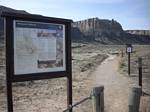 Wildwood Drive Trailhead |
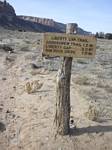
|
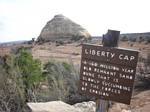 Liberty Cap Prehistoric Sand Dune |
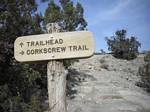 Corkscrew trail |
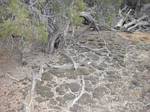 Cryptogamic Soil [see above] |
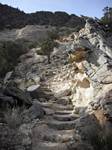
|

|
Click Here for a YouTube video of my climb up Liberty Cap in the Colorado National Monument! |

Did You Know?
Hiking Waypoints

For personal safety, and just for the fun of it, I usually take a GPS "reading" on the top of each peak, at the trailhead, or some other interesting point or curiosity along the way. WARNING: I cannot guarantee the accuracy of these waypoints as my own GPS bounces around a lot or I simply take an incorrect reading! Please rely on a more accurate source for your Waypoints! That being said, I still enjoy "cataloging" Waypoints and I keep a bunch of other locations, from around the world, on my 12ers, 13ers, 14ers, Waypoints, and other pages...
|
|

Death Valley - Telescope Peak
3,366 metres (11,043 feet)
June 7, 2011
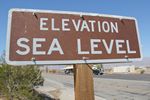 1. Stove Pipe Wells |
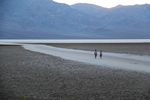 2. Badwater Basin - minus 282 feet |
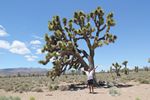 3. Me and a Joshua Tree |
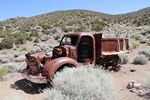 4. Truck |
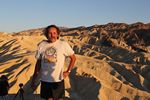 5. Me at Zabriskie Point |
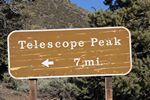 6. Mahogony Flat Trailhead |
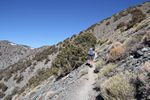 7. Jeff going up |
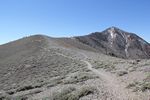 8. Looking up the trail to Telescope |
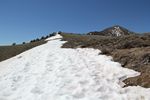 9. Snow on Telescope Peak |
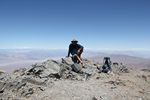 10. Me on top |
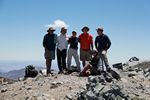 11. All six of us on top! |
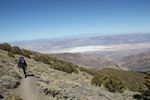 12. Ken heading down |

|
Click Here for a YouTube video through the cave to the top of Harney Peak... |

|
Click Here for, Only the Essential: Pacific Crest Trail Documentary |

The Case Against Poles
(Hiking poles that is, not the people of central Europe!)
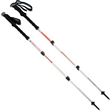
|
Although I read and enjoyed all of Collin Fletcher's books during the late 60s and early 70s (The Complete Walker, The Man Who Walked Through Time, The Thousand-Mile Summer, etc.) I never agreed with him on the use of a walking stick (He called it a walking staff). But, to his credit (p. 37 of "Walker"), Fletcher had admitted that, "...the vast majority of walkers never even think of using a walking staff, I unhesitatingly include it among the foundations of the house that travels on my back." However, I don't think Collin Fletcher or Roger Wendell ever imagined that, two decades later, the European craze of hiking with ski poles would have caught on so soundly not only in Colorado, but around North America and the world as well! |
So, here it is in late 2010 as almost everywhere I hike, backpack, or climb I see people using hiking poles. Now, of course, these poles are much more sophisticated than the simple ski poles we saw on Colorado's hiking trails in the late 80s. The modern hiking pole is sleek, light, spring-loaded, collapsible, and very expensive. Obviously I'm not going to dissuade anyone from using hiking poles. Nevertheless, let me list the reasons why I, myself, have never used them (and probably never will):
- Generally, but not always, the people who use poles can't keep up the pace or distance anyway - otherwise they probably wouldn't be experimenting with poles in the first place!
- The poles strengthen the user's arms but weaken their legs - especially their knees. Often, when users don't have access to their poles they complain about the pain, etc.
- The poles make too much noise. In Colorado we don't have too many "duff" covered trails like those in more wooded areas around the globe. So, on a still, quiet day in the backcountry you can usually hear a party's hiking poles clanking and scraping over the hard granite surfaces that usually line our trails.
- The poles, at times, poke other people by accident (at least I think those were accidents...).
- Poles aren't cheap - I've seen 'em for sale at over $100 - at a time when $100 could still buy 40 gallons of gasoline!
- Hiking poles are a packing nuisance (It was required I use a set in Africa but, back then, they didn't fit in my luggage. Thankfully the airlines lost them before we started our hike...).
- People can't climb or scramble with poles and always have to pass them along the trail, to other people, over the most difficult parts. On some of Colorado's more difficult 14ers it's not uncommon to find a few sets of hiking poles stashed beneath some rocks along a steep portion of the route - hopefully to be found by their owners when down-climbing...
- Poles are an extreme lightning hazard. But, of course, so is an ice axe or anything else that's metallic that you're not careful with...
- Not a big deal but poles poke a "ton" of small holes along each side of the trail. I've seen muddy trails lined with thousands of "pock marks" their entire length. Again, not sure what permanent damage this causes other than obviously widening the trail in places where it was simply okay to get your boots a little muddy!
- Many, many times I've seen a person's pole get stuck in some rocks or other obstacle requiring the user to, at a minimum, stop their work or even devote considerable effort to yanking the thing back out.
- Poles require a lot more effort to control on a glissade than an ice axe. And, I've seen people break poles on glissade many times!
Okay, I've brought my argument up in "public" and have had a few mountaineers come down on me since they're so accustomed to using hiking poles with great success. Admittedly, I'm not going to change anyone's mind, and, obviously, if you need poles for some medical reason, or at the direction of your doctor, don't give 'em up because of something you read on some goofy website (including this one!). Nevertheless, for the record, when the going gets rough I'm going to continue with my ice axe - I just never got "into" hiking poles and my knees still felt pretty darn good at age 55 when I was making this entry!

Yosemite Decimal System
The Yosemite Decimal System (YDS) is a three-part system used for rating the difficulty of hikes and climbs. YDS is primarily used by mountaineers in the United States and Canada. However, there are many different rating systems used around the world. Examples include the British trad grade, the French sport grade, and the International Climbing and Mountaineering Federation's (UIAA) alpine grade. As for the YDS, it was first devised by members of the Sierra Club in Southern California in the 1950s. YDS was a refinement of earlier systems, particularly those developed in Yosemite Valley.Class 1: Hiking on a trail.
Classification of climbs can vary quite a bit depending on location and history. Indoor gym ratings tend to be inflated compared to outdoor ratings. Ratings tend to be lower in outdoor areas where climbing routes were developed in earlier years. Guidebooks have often raised the ratings on older climbs to make them more comparable to newer ratings. The YDS grade system also involves an optional Roman numeral grade that indicates the length and seriousness of the route. The grades are:
| Grade | Duration |
|---|---|
| I | One to two hours of climbing |
| II | Less than half a day |
| III | Half a day climb |
| IV | Full day climb |
| V | A climb lasting 2–3 days |
| VI | A climb lasting 4–6 days |
| VII | A climb lasting a week or longer |

Links:
| Warning! Climbing, mountaineering, and backcountry skiing are dangerous and can seriously injure or kill you. By further exploring this website you acknowledge that the information presented here may be out of date or incorrect, and you agree not to hold the author responsible for any damages, injuries, or death arising from any use of this resource. Please thoroughly investigate any mountain before attempting to climb it, and do not substitute this website for experience, training, and recognizing your limitations! |

 Back to Roger J. Wendell's Home Page...
Back to Roger J. Wendell's Home Page...
Abbey |
About |
Blog |
Contacting
Me |
Copyright |
Disclaimer |
Donate |
Guest
Book |
Home |
Links |
Site
Index |
Solutions |
Terms,
Conditions
and
Fair
Use |
What's
Changed
or
New?
Copyright
© 1955 -